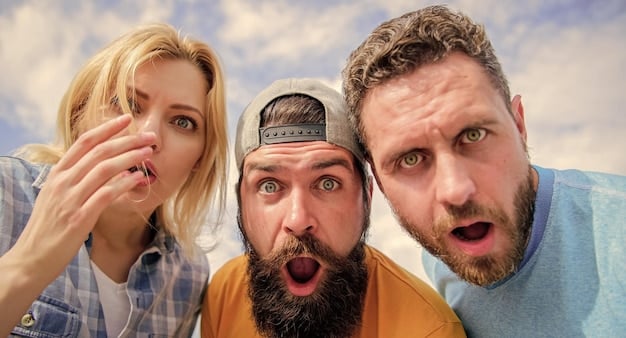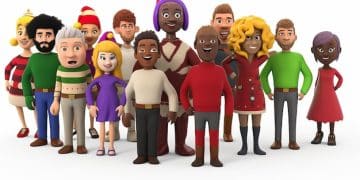The Art of Sitcom Catchphrases: Iconic Comedy Series Lines

The Art of the Sitcom Catchphrase: 3 Comedy Series Lines That Became Cultural Phenomena explores how memorable lines from comedy shows transcend entertainment, embedding themselves in everyday language and cultural references, shaping how we communicate and perceive humor, highlighting lasting impact.
Sitcom catchphrases have a unique power. They’re not just throwaway lines; they become ingrained in our collective consciousness. Let’s explore The Art of the Sitcom Catchphrase: 3 Comedy Series Lines That Became Cultural Phenomena that have left an indelible mark on popular culture.
The Enduring Appeal of Sitcom Catchphrases
Sitcom catchphrases are more than just funny quips; they represent shared experiences and cultural touchstones. They evoke nostalgia and create instant connections between people who recognize and appreciate the reference.
These phrases often encapsulate the essence of a character or a show, becoming shorthand for understanding their humor and personality.
Why Catchphrases Stick With Us
Several factors contribute to the lasting power of sitcom catchphrases.
- Repetition: Constant repetition throughout a series reinforces the catchphrase in the viewer’s mind.
- Character Association: The phrase becomes inextricably linked to a beloved character, enhancing its memorability.
- Cultural Relevance: Catchphrases that resonate with broader cultural themes have a higher likelihood of becoming widely adopted.
The art of crafting a truly iconic catchphrase involves a delicate balance of humor, character development, and cultural timing. When all these elements align, a simple line can transform into a legendary piece of television history.

“How You Doin’?” – Friends
“How you doin’?” is arguably one of the most recognizable sitcom catchphrases of all time. Made famous by Joey Tribbiani from Friends, it wasn’t just a greeting; it was a signature move.
This simple yet effective line perfectly encapsulated Joey’s confident, sometimes clueless, and always charming personality.
The Joey Effect
The impact of “How you doin’?” extends far beyond the confines of Central Perk.
- Instant Recognition: Uttering the phrase immediately conjures up images of Joey and the entire Friends gang.
- Pickup Line Parody: It became a widely parodied pickup line, often used humorously (and sometimes unsuccessfully) in real-life dating scenarios.
- Cultural Integration: The phrase has been referenced in countless other TV shows, movies, and even advertising campaigns.
The genius of “How you doin’?” lies in its simplicity and versatility. It’s a line that can be used in almost any situation, making it endlessly quotable and enduringly popular.
“Did I Do That?” – Family Matters
From the beloved sitcom Family Matters, comes the iconic line “Did I do that?”. Uttered by the lovable neighbor Steve Urkel after some series of accidental chaos, the line is almost as synonomous with the 90’s as the sitcom that birthed it.
Urkel was portrayed as clumsy but lovable with good intentions. “Did I do that?” came to represent the misadventures that the audience both loved and anticipated.
The Urkel Phenomenon
What made “Did I do that?” a 90’s hallmark? Here are a few ideas:
- The Underdog Through all of his blunders, Urkel was portrayed as the underdog. His trademark line only added to the lovability of the character.
- A Show For Everyone Family Matters was a sitcom with wholesome lessons for the whole family. No matter your age, there was something endearing with the character to love.
- Simplicity The simplicity of the line paired with the mischeif of the character made for a line that was quick, humorous, and perfectly timed.
The staying power of “Did I do that?” is something that continues to make the 90’s sitcom so endearing, even today.

“Legendary!” – How I Met Your Mother
Barney Stinson’s “Legendary!” from How I Met Your Mother is a more recent addition to the sitcom catchphrase hall of fame, but it has quickly cemented its place as a modern classic.
This exclamation, typically delivered after a successful (or sometimes not-so-successful) stunt, perfectly embodies Barney’s larger-than-life personality and his unwavering belief in his own awesomeness.
The Barney Stinson Guide to “Legendary!”
What makes “Legendary!” so legen…wait for it…dary?
- Exaggeration and Hyperbole: It’s the ultimate expression of enthusiasm, turning even mundane events into epic tales.
- Self-Aware Humor: The show often poked fun at Barney’s over-the-top antics, making the catchphrase even funnier.
- Catchphrase Evolution: The phrase evolved throughout the series, often accompanied by hand gestures or other visual cues, adding to its comedic impact.
“Legendary!” is more than just a catchphrase; it’s a state of mind. It’s about embracing life’s adventures (no matter how ridiculous) and celebrating the moments that make life, well, legendary.
The Science Behind a Great Catchphrase
What separates a forgettable line from a catchphrase that becomes a cultural phenomenon? While there’s no guaranteed formula, certain elements contribute to a catchphrase’s success.
Analyzing these components can provide valuable insights into the art of crafting a truly memorable and impactful phrase.
Key Components of a Hit Catchphrase
Here are some critical factors that elevate a catchphrase from ordinary to extraordinary:
- Brevity: Shorter catchphrases are generally more memorable and easier to repeat.
- Relatability: Catchphrases that tap into universal human experiences or emotions tend to resonate more widely.
- Delivery: The actor’s delivery is crucial; a well-delivered line can transform a mediocre phrase into a comedic goldmine.
Consider the use of alliteration and assonance within the phrase. While these literary devices aren’t always necessary, they can add a melodic quality that enhances memorability. In addition, cultural context matters. A catchphrase that aligns with current trends is more likely to gain traction and become a cultural phenomenon quickly compared to one that may not align with the current zeitgeist.
Beyond the Laughs: The Impact of Catchphrases
Sitcom catchphrases are entertaining, but they also have a surprisingly significant impact on our language and culture. They influence how we communicate, how we perceive humor, and how we remember certain shows and characters.
Exploring this deeper impact reveals the true power of a well-crafted catchphrase.
Catchphrases in Everyday Life
The influence of these lines can be seen in various aspects of our lives.
- Language and Communication: Catchphrases often become part of our everyday vocabulary, used in casual conversations and even professional settings.
- Nostalgia and Memory: They evoke fond memories of the shows and characters we grew up watching, creating a sense of shared nostalgia.
- Cultural References: Catchphrases are frequently referenced in other forms of media, solidifying their place in popular culture.
The way in which people embrace catchphrases in their everyday interactions really speaks to their social nature. Humans are social creatures, and using familiar phrases and references creates a sense of connection through shared experience. In the era of podcasts, reality shows, and streaming services, it’s always remarkable just how entrenched a sitcom catchphrase can become in the overall pop-culture landscape.
Creating Your Own Catchphrase
While crafting a catchphrase with the staying power and cultural impact can be challenging, understanding the key components can increase your chances of success.
Developing a set of catchphrases can add depth to character as well as add brand recognition to your show, blog, or any sort of creative content.
Tips for Crafting a Memorable Catchphrase
Consider these suggestions when developing your own catchphrases:
- Understand Your Audience: Tailor your phrases to resonate with your target demographic.
- Keep It Simple and Catchy: Aim for phrases that are easy to remember and repeat.
- Embrace Authenticity: Create phrases that genuinely reflect the character or brand you’re representing.
By keeping these rules in mind, developing catchphrases can add value to your character, brand, and/or business. Not only can the phrases add a bit of levity to your interactions but they can create an identity that the audience can latch on to.
| Key Point | Brief Description |
|---|---|
| 🗣️ Catchphrase Power | Sitcom catchphrases leave memorable impressions on pop culture. |
| 📺 “How you doin’?” | Popularized by Friends, the catchphrase encapsulated the personality of Joey. |
| 🤓 “Did I do that?” | Steve Urkel’s mishap hallmark continues to be relevant in modern pop culture. |
| 🌟 “Legendary!” | Is any explanation needed? Barney Stinson gives definition to what is “Legendary!”. |
FAQ
▼
Sitcom catchphrases gain popularity through repetition, association with beloved characters, and cultural relevance. When these elements converge, phrases embed themselves in our memeory and are easily recalled.
▼
Brevity and relatability are essential for making a catchphrase. Memorable delivery of the line really solidifies and contributes to a phrase’s overall recognition and integration into pop culture.
▼
Catchphrases become ingrained in daily vocabulary, foster nostalgia, and are used as cultural references. They provide viewers with a shared comedic moment.
▼
The list of catchphrases from sitcoms across the decades is endless. “Yada, Yada, Yada” from Seinfeld, “We were on a Break!” from Friends, and “That’s what she said” from The Office are just a few examples.
▼
They are not! Although iconic catchphrases are always associated with television, catchphrases are used to brand all sorts of businesses, products, and brands across all industries and markets.
Conclusion
Sitcom catchphrases are a fascinating blend of humor, character development, and cultural context. They’re not just throwaway lines; for many viewers the lines evoke fond memories of the shows and characters they grew up with, and their influence extends far beyond the realm of television. From Joey’s pickup line to Barney’s enthusiastic exclamation or Urkel’s mischevious catchphrase, these phrases have become an integral part of our shared cultural vocabulary.





